
Bundesautobahn 1 is an autobahn in Germany. It runs from Heiligenhafen in Schleswig-Holstein to Saarbrücken, a distance of 749 km (465 mi), but is incomplete between Cologne and Trier. B 207 continues north from Heiligenhafen to Puttgarden, at the end of the island of Fehmarn, with a ferry to Rødby, Denmark.

Bundesautobahn 7 is the longest German Autobahn and the longest national motorway in Europe at 963 km. It bisects the country almost evenly between east and west. In the north, it starts at the border with Denmark as an extension of the Danish part of E45. In the south, the autobahn ends at the Austrian border. This final gap was closed in September 2009.

Bundesautobahn 8 is an autobahn in southern Germany that runs 497 km (309 mi) from the Luxembourg A13 motorway at Schengen via Neunkirchen, Pirmasens, Karlsruhe, Pforzheim, Stuttgart, Ulm, Augsburg and Munich to the Austrian West Autobahn near Salzburg.

Bundesautobahn 94 is an autobahn in southern Germany. When completed, it will connect Munich with Passau. Currently, only the parts Munich-Burghausen, and Malching-Kirchham have been built. Between Burghausen and Simbach am Inn, there is a 14 kilometer, two-lane section that is signed as Bundesstraße 12. Provisions for an upgrade to A 94 exist here.

Bundesautobahn 2 is an autobahn in Germany that connects the Ruhr area in the west to Berlin in the east. The A 2 starts at the junction with the A3 near the western city of Oberhausen, passes through the north of the Ruhr valley, through the Münsterland and into Ostwestfalen, crossing the former inner German border and continuing through the Magdeburger Börde to merge into the Berliner Ring shortly before reaching Berlin. Major cities such as Magdeburg, Braunschweig, Hannover and Dortmund are situated very close to the A 2. The A 2 is one of the most important autobahns, connecting several large industrial areas with each other.
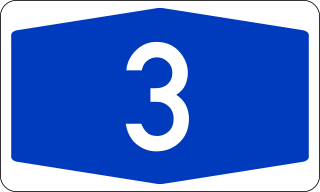
Bundesautobahn 3 is an autobahn in Germany running from the Germany-Netherlands border near Wesel in the northwest to the Germany-Austria border near Passau.

Bundesautobahn 4 is an autobahn in two discontinuous segments that crosses Germany in a west–east direction. The western segment has a length of 156 km (97 mi), while the part in the east is 429 km (267 mi) long.

Bundesautobahn 6, also known as Via Carolina is a 477 km (296.4 mi) long German autobahn. It starts at the French border near Saarbrücken in the west and ends at the Czech border near Waidhaus in the east.

Bundesautobahn 5 is a 445 km (277 mi) long Autobahn in Germany. Its northern end is the Hattenbach triangle intersection. The southern end is at the Swiss border near Basel. It runs through the German states of Hessen and Baden-Württemberg and connects on its southern ending to the Swiss A 2.

Bundesautobahn 9 is an autobahn in Germany, connecting Berlin and Munich via Leipzig and Nuremberg. It is the fifth longest autobahn spanning 529 km (328.71 mi).
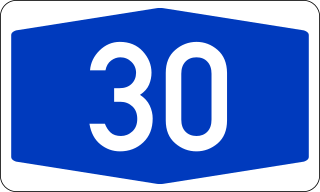
Bundesautobahn 30 is a highway in northwestern Germany. It runs from west to east, starting at the Dutch border. On the border it connects with the Dutch A1 motorway, hence, the A 30 is part of the important European connection Berlin – Amsterdam. It is an important connection from Hannover and Minden to Osnabrück, Münster and the Netherlands, and part of European Route E 30.

Bundesautobahn 11 is an autobahn in eastern Germany that was opened in 1936. As it is partly in a dilapidated state, it is currently undergoing modernisation works on various stretches. The road forms the main connection between Berlin and Szczecin, and it is connected to the Polish motorway A6 at Mecklenburg-Vorpommern.

Bundesautobahn 15 is an autobahn in eastern Germany. It is one of the original Reichsautobahns and connected Breslau to Berlin, via Wrocław (Breslau) and Görlitz. It connects Germany and Poland. A 15 is part of European route E36.
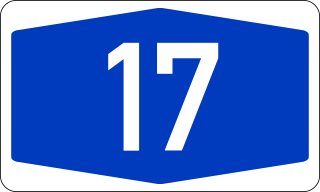
Bundesautobahn 17 is an autobahn in Saxony, south-eastern Germany. It links Dresden to the Czech border where the D8 continues to Prague. The road is a fairly new contribution to the German autobahn network. Construction began in 1998, with the first stretch opening in 2001 and the last in 2006.
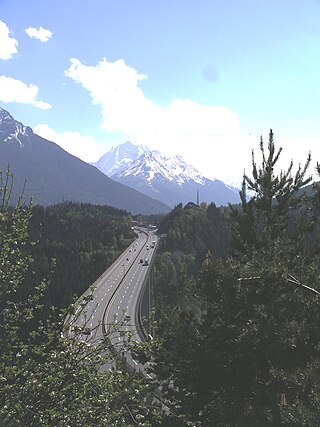
The Austrian autobahns are controlled-access highways in Austria. They are officially called Bundesstraßen A (Bundesautobahnen) under the authority of the Federal Government according to the Austrian Federal Road Act (Bundesstraßengesetz), not to be confused with the former Bundesstraßen highways maintained by the Austrian states since 2002.
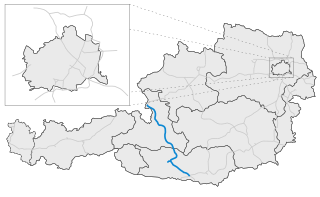
The Tauern Autobahn is an autobahn (motorway) in Austria. It starts at the Salzburg junction with the West Autobahn (A1), runs southwards, crosses the Tauern mountain range on the main chain of the Alps and leads to the Süd Autobahn (A2) and Karawanken Autobahn (A11) at Villach in Carinthia.

Berlinka is the informal Polish and Russian name given to sections of the unfinished Reichsautobahn Berlin-Königsberg, which was a pre-World War II German Reichsautobahn project to connect Berlin with Königsberg in East Prussia. In the late 1930s, the sections near these two cities were finished, but not the larger section in between. The German demand in 1939 to run this road across the Polish Corridor with extraterritorial status and Poland's refusal to allow this were used by Nazi Germany as a pretext to start a war. During the war, the Germans did not continue construction on a large scale and the route was never built. After the war, the German Democratic Republic, the Polish People's Republic and the Soviet Union's Kaliningrad Oblast inherited the remnants.

The Süd Autobahn (A2) is a motorway (Autobahn) in Austria. Completed in 1999, it runs from the outskirts of Vienna south via the cities of Graz and Klagenfurt to the border of Italy at Arnoldstein, where it joins the Autostrada A23. With a total length of 377.3 km (234.4 mi), the A2 is Austria's longest motorway.

The Inn Valley Motorway or Inntal Autobahn A12 is an autobahn in the Austrian federal state of Tyrol and part of Euroroutes E45 and E60.
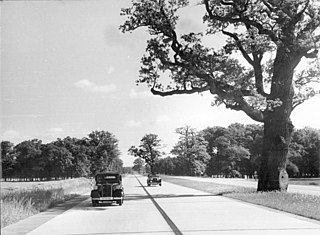
The Reichsautobahn system was the beginning of the German autobahns under Nazi Germany. There had been previous plans for controlled-access highways in Germany under the Weimar Republic, and two had been constructed, but work had yet to start on long-distance highways. After previously opposing plans for a highway network, the Nazis embraced them after coming to power and presented the project as Hitler's own idea. They were termed "The Fuehrer's roads" and presented as a major contribution to the reduction of unemployment. Other reasons for the project included enabling Germans to explore and appreciate their country, and there was a strong aesthetic element to the execution of the project under the Third Reich; military applications, although to a lesser extent than has often been thought; a permanent monument to the Third Reich, often compared to the pyramids; and general promotion of motoring as a modernization that in itself had military applications.

























